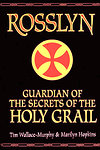
Tim Wallace-Murphy
Författare till Rosslyn: Guardian of the Secrets of the Holy Grail
Om författaren
Tim Wallace-Murphy studied medicine at University College, Dublin, and then trained as a psychologist. He is now an author, lecturer and historian and has spent over thirty years following a spiritual path. He has written several bestsellers, including Rex Deus: The True Mystery of Rennes-le-Chteau visa mer and Rosslyn: Guardian of the Secrets of the Holy Grail (with Marilyn Hopkins), which provided invaluable source material to Dan Brown for his bestselling novel, The Da Vinci Code. visa färre
Verk av Tim Wallace-Murphy
Taggad
Allmänna fakta
- Födelsedag
- 1930-01-13
- Kön
- male
- Nationalitet
- UK
- Organisationer
- Freemasons
Medlemmar
Recensioner
Du skulle kanske också gilla
Associerade författare
Statistik
- Verk
- 13
- Medlemmar
- 854
- Popularitet
- #29,958
- Betyg
- 3.1
- Recensioner
- 7
- ISBN
- 53
- Språk
- 7














Rosslyn is a modest chapel (it was apparently intended to be a full-fledged church, but was never completed) about 7 miles south of Edinburgh. It has especially ornate stone carvings, which are woo-woo fodder – the carvings are complex enough that given time and enthusiasm it’s possible to find all sorts of coded messages in them. If authors Tim-Wallace-Murphy and Marilyn Hopkins had been content to just make esoteric interpretations of the stonework, the book might have actually had some utility – you could read around the woo-woo and draw your own conclusions.
Instead, despite the title, there’s not very much about Rosslyn here. The authors wander around Europe on a woo-woo pilgrimage to various sites – Compostela, Chartres, Amiens, Toulouse, Notre Dame, Orleans – which are all supposedly stations on a initiate’s journey to enlightenment. No woo-woo is left unwooed, as Wallace-Murphy and Hopkins invoke the ancient Egyptians, the Pythagoreans, the Romans, the Essenes, the Druids, the Gnostics, the Templars and the Freemasons through alchemy, dowsing, astrology, telluric energy, ley lines, meditation and the chakras to determine Rosslyn is the hiding place of the Lost Treasure of the Templars, The Holy Grail, and the Ark of the Covenant. I was especially amused by the mix of mystical traditions; it was enlightening to learn that medieval Templars knew all about Hindu chakras and prāna energy, and that they routinely sent expeditions to the New World (oddly, there’s no mention of the Rosslyn carving that is supposed to represent a pre-Columbian ear of maize). This is mostly documented by references to the author’s other works and the sensations they felt while meditating, with now and then another woo-woo book thrown in. Alas, the book isn’t even useful as a debunking reference, since there’s virtually nothing than can be pinned down long enough to be rationally refuted.
Oh, and according to the authors’ interpretation of the sites as a horoscope, the world will end (or, at least, something will happen) on July 28 2019.… (mer)